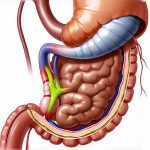Indigestion, a common discomfort experienced by many, is often broadly categorized as either ‘functional’ or ‘organic’. While both manifest similarly – typically presenting as bloating, nausea, heartburn, and abdominal pain – understanding the underlying cause is crucial for appropriate management and peace of mind. The perception that indigestion is simply a minor inconvenience can sometimes lead to overlooking potentially serious conditions, while simultaneously causing unnecessary anxiety over functional issues. It’s important to remember that digestive systems are complex, and what feels like a simple upset stomach could be indicative of something more significant or entirely benign. This article will delve into the distinctions between these two types of indigestion, exploring their causes, diagnostic approaches, and general management strategies (always in consultation with a healthcare professional).
The term ‘indigestion’ itself is somewhat vague, describing a collection of symptoms rather than a specific disease. Functional indigestion, also known as non-ulcer dyspepsia, refers to chronic discomfort without any identifiable structural or biochemical abnormalities when investigated through standard tests. Organic indigestion, on the other hand, arises from a demonstrable physical cause – an underlying medical condition affecting the digestive system. The key difference lies in detectability; organic indigestion has a clear root that can be identified through diagnostics, while functional indigestion doesn’t, despite causing significant symptoms for those who experience it. This distinction profoundly impacts how these conditions are approached and managed.
Functional Indigestion: When Tests Come Back Clear
Functional indigestion is incredibly common, affecting a substantial portion of the population. It’s often characterized by persistent or recurrent discomfort in the upper abdomen, including sensations of fullness (early satiety), bloating, nausea, and burning – all without evidence of structural disease. The precise cause remains elusive, but current research points to several contributing factors including increased visceral sensitivity (meaning a heightened awareness of normal digestive processes), delayed gastric emptying, Helicobacter pylori infection (even if not causing ulcers), psychological stress, and gut microbiome imbalances. It’s important to note that this isn’t “all in your head”; the discomfort is very real, even if traditional tests don’t reveal a physical abnormality.
Many individuals with functional indigestion report feeling full quickly after eating only small amounts of food. This can lead to significant dietary restrictions and impact quality of life. The condition often fluctuates, with periods of exacerbation and remission, making it challenging to pinpoint triggers. Furthermore, the psychological component is substantial; stress, anxiety, and depression can all worsen symptoms, creating a vicious cycle. The brain-gut axis – the bidirectional communication system between the digestive tract and the brain – plays a pivotal role in functional indigestion, meaning emotional state directly influences gut function, and vice versa.
Management of functional indigestion typically focuses on symptom relief and lifestyle modifications. This might include dietary changes (avoiding trigger foods like caffeine, alcohol, spicy foods, and fatty meals), stress management techniques (mindfulness, yoga, meditation), probiotics to support a healthy gut microbiome, and in some cases, medications to address specific symptoms like nausea or bloating – again under the guidance of a healthcare professional. Cognitive behavioral therapy (CBT) can also be incredibly helpful for addressing the psychological component and learning coping strategies. It’s vital to rule out organic causes first before assuming functional indigestion, ensuring that underlying conditions aren’t missed. Understanding the difference between stomach sensitivity can also be helpful in identifying the source of your discomfort.
Organic Indigestion: Identifying the Underlying Cause
Organic indigestion, in contrast to its functional counterpart, stems from a demonstrable physical problem within the digestive system. This could range from relatively common conditions like gastroesophageal reflux disease (GERD) and peptic ulcers to more serious issues like gallbladder disease, pancreatitis, or even certain types of cancer. The symptoms often overlap with functional indigestion – heartburn, bloating, nausea, abdominal pain – but are typically accompanied by other specific indicators related to the underlying condition. For instance, GERD might present with a persistent sour taste in the mouth and acid reflux, while peptic ulcers may cause more intense, gnawing pain that worsens on an empty stomach.
The diagnostic process for organic indigestion involves a thorough medical history, physical examination, and various tests designed to identify the root cause. These tests can include: – Endoscopy (to visualize the esophagus, stomach, and duodenum) – Biopsy (to check for inflammation, infection, or cancerous cells) – Blood tests (to assess liver function, pancreatic enzymes, and H. pylori infection) – Stool tests (to detect infections or malabsorption issues) – Imaging studies (like ultrasound, CT scan, or MRI) to evaluate the gallbladder, pancreas, and other organs. The goal is not simply to confirm indigestion but to identify why it’s happening.
Treatment for organic indigestion is targeted at addressing the underlying condition. GERD might be managed with lifestyle changes, medications to reduce acid production (like proton pump inhibitors), or even surgical intervention in severe cases. Peptic ulcers are typically treated with antibiotics to eradicate H. pylori infection and medications to suppress stomach acid. Gallbladder disease may require gallbladder removal, while pancreatitis necessitates hospitalization and supportive care. The key difference is that organic indigestion isn’t about managing symptoms alone; it’s about treating the source of the problem. It can be difficult to differentiate between acidic and alkaline reflux without proper testing.
Distinguishing Between the Two: A Closer Look
Differentiating between functional and organic indigestion can be challenging because of overlapping symptoms. However, several clues can help healthcare professionals narrow down the diagnosis. The onset of symptoms is often telling – organic indigestion tends to develop more acutely or progressively with a clear trigger, while functional indigestion often presents gradually over time. The nature of the pain also differs; organic causes may involve sharper, more localized pain, whereas functional indigestion is typically described as diffuse and less intense.
Another important factor is response to treatment. Organic indigestion usually improves significantly with targeted therapy addressing the underlying cause. For example, GERD symptoms should subside with acid-reducing medications. Functional indigestion, on the other hand, may show limited or delayed improvement with these treatments. This doesn’t mean functional indigestion isn’t serious; it simply highlights the need for a different approach focused on symptom management and lifestyle modifications as previously discussed. It is also crucial to consider the patient’s medical history, family history, and any concurrent medications they are taking.
The Rome IV criteria are often utilized by physicians to diagnose functional dyspepsia (a specific type of functional indigestion). These criteria focus on symptom patterns and exclude organic causes through appropriate testing. It’s important to remember that diagnosis is a process, not a single event. Multiple assessments, tests, and careful consideration of the patient’s overall health are required to arrive at an accurate conclusion. Many people struggle with identifying the difference between allergy and sensitivity which can impact dietary choices.
The Role of Lifestyle and Diet
Regardless of whether indigestion is functional or organic, lifestyle and dietary modifications play a crucial role in management. Avoiding trigger foods – caffeine, alcohol, spicy foods, fatty meals, carbonated beverages – can significantly reduce symptoms for both types. Eating smaller, more frequent meals instead of large ones can also help prevent bloating and discomfort. Maintaining a healthy weight, quitting smoking, and managing stress are all beneficial strategies.
For organic indigestion, dietary changes might be tailored to the specific condition. For example, individuals with GERD may need to avoid foods that trigger acid reflux (chocolate, peppermint, tomatoes). Those with gallbladder disease should limit their intake of fatty foods. In functional indigestion, identifying individual food sensitivities and intolerances can be helpful – an elimination diet under the guidance of a registered dietitian can assist in this process. Hydration is also essential, as it aids digestion and prevents constipation, which can exacerbate symptoms.
The gut microbiome’s influence on both types of indigestion is increasingly recognized. A diverse and healthy gut microbiome supports optimal digestive function and immune regulation. Consuming probiotic-rich foods (yogurt, kefir, sauerkraut) or taking a probiotic supplement (after consulting with a healthcare professional) may be beneficial. However, it’s crucial to remember that probiotics are not a one-size-fits-all solution, and the best approach varies depending on individual needs. Understanding gut inflammation and diarrhea can help you make informed choices about your diet.
When To Seek Medical Attention
While many cases of indigestion resolve on their own or with simple lifestyle changes, certain symptoms warrant prompt medical attention. These include: – Difficulty swallowing (dysphagia) – Unintentional weight loss – Persistent vomiting – Severe abdominal pain – Blood in the stool or vomit – Anemia – Family history of gastrointestinal cancer. These could be signs of a more serious underlying condition that requires immediate diagnosis and treatment.
It’s also important to seek medical attention if indigestion symptoms are chronic, recurrent, or significantly interfere with your daily life. Don’t self-diagnose or attempt to treat severe indigestion without professional guidance. A healthcare provider can accurately assess your symptoms, perform appropriate tests, and develop a personalized management plan. Remember that early diagnosis is key for optimal outcomes. Indigestion shouldn’t be ignored, especially if accompanied by alarm symptoms. If you experience discomfort after eating, consider tight waistbands and digestive flow.
Ultimately, understanding the difference between functional and organic indigestion empowers individuals to take control of their digestive health and seek appropriate care when needed. While both types can cause significant discomfort, recognizing the underlying cause allows for targeted management strategies and improved quality of life. Remember that a collaborative approach – working closely with a healthcare professional – is essential for navigating this complex condition and achieving lasting relief. The difference between GERD and functional heartburn can be difficult to identify without medical advice.


















